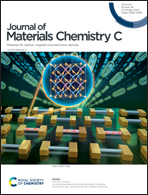Excellent energy storage density and efficiency in lead-free Sm-doped BaTiO3–Bi(Mg0.5Ti0.5)O3 ceramics†
Abstract
Progress in energy storage ceramics for applications has been of interest owing to their clean green nature and excellent ferroelectric/dielectric performances. In this study, lead-free Sm-doped 0.95BaTiO3–0.05Bi(Mg0.5Ti0.5)O3 (BT–BMT–xSm) relaxor ferroelectric ceramics were synthesized and confirmed to be an appropriate material for storage devices. After the introduction of Sm2O3 into BT–BMT ceramics, their hysteresis loops gradually shrank and became slender, which is beneficial to achieving high efficiency energy storage in ceramic capacitors. The maximum recoverable energy density for the BT–BMT–xSm (x = 0.03) sample reached 3.86 J cm−3 at normal temperature, and its corresponding energy efficiency reached 81.6%. Moreover, it was found from impedance spectroscopy that the breakdown field strength is related to the oxygen defect content in the samples. Ceramic samples with fewer defects have better insulation performance, which means that a high breakdown field strength will be obtained. With proper doping, enhanced relaxor behaviour and breakdown field strength were obtained to achieve excellent energy storage properties.



 Please wait while we load your content...
Please wait while we load your content...